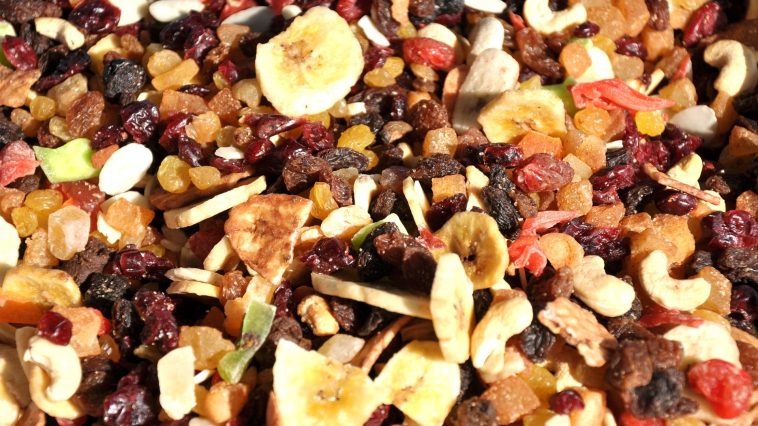Fruit that has had almost all of the water content removed through drying methods is referred to as dried fruit. The fruit shrinks during this process, leaving a small, energy-dense dried fruit.
The most common forms of dried fruits are raisins, dates, prunes (dried plums), figs, apricots, and peaches. Fruits such as dried mango, pineapple and berries are also available, but these tend to be dried with added sugar.
Dried fruits less commonly produced include Zante currants, black mulberry, white mulberry, physalis, Aronia (chokeberries), sea-buckthorn, raspberry, kumquats, white raisins (dried in the shade), blueberries, goji, cherries, cranberries, sour cherries, and barberries. According to Parma Anand, in the article History of Dry Fruits, conventional dried fruits have been a staple food of Mediterranean regimens for centuries. Their initial appearance can be traced back to the Middle Eastern district known as the Fertile Crescent, made up of parts of current Iran, Iraq, southwest Turkey, Syria, Lebanon, Israel, and northern Egypt. Drying or drying out additionally happened to be the most punctual type of sustenance conservation: grapes, dates and figs that tumbled from the tree or vine would dry in the hot sun.
Early seeker gatherers saw that these fallen organic products took on an eatable structure and esteemed them for their steadiness just as their concentrated sweetness. The main purpose of drying fruits is for preservation purposes. The process increases the shelf-life of products, it reduces hazards from microbial pathogens and spoilage. It ensures an all-year-round availability of seasonal fruits and increased availability of convenience fruits (such as ready-to-serve beverages and instant mixes). Preservation in some cases produces a different form of the products which are of great importance in various cuisines for example, raisins, squash, and wines made from grapes.
The process of drying fruits is not a precise method of food preservation, because drying time is not fixed and will rely on the equipment, moisture content of the fruit, and the humidity in the air during the process. The following are the various types of drying employed: sun drying; tray drying; drum drying; fluidized bed drying; freeze drying; vacuum drying; osmotic drying and microwave drying.
In dryers the drying process can either be adiabatic drying were the fruits are dried by direct contact with hot air, or non-adiabatic drying in which an external medium is used to transfer heat. Sun drying involves spreading the fruit in thin layers on paved grounds and expose it to sun and wind for drying. It is a slow and inexpensive process; however, the downside is environmental contamination. Exposure to natural elements increases chances of insect infestation and microbial deterioration which decreases the quality of the fruit. When fruits are placed in a thin layer in shallow mesh or perforated trays it is referred to as tray drying. Hot air is then blown through a system of ducts and baffles to promote uniform air distribution.
Drum drying occurs when fruits are spread over a heated drum surface. The drum rotates, with fruits on the drum surface for the greater part of the rotation and during the time the drying takes place, after which the dried material is scraped off. With fluidized bed drying, heat is transferred to fruits by convection. Hot air is blown upwards directly from under the fruits, causing them to lift and remain suspended against gravity. There may also be a horizontal air flow helping to convey the fruits through the dryer.

Dried fruits are tasty, healthy, and easy to store.
Lyophilisation, also known as freeze drying, is based on the sublimation principle. It freezes the fruits first, then reduces pressure and adds heat for frozen water in the fruits to sublimate. There are four stages in this: pre-treatment, freezing, primary drying, and secondary drying. It is an excellent method for preserving heat-sensitive fruits. Vacuum drying involves removal of moisture by means of creating a vacuum. Pressure is reduced to below the vapour pressure of water surrounding the fruits and increases drying rate. In osmotic drying syrup is generally used as a solute for fruits. Water is removed from fruits to an osmo-active solution and transfer of solute in the fruits happens. Due to the colour, aroma, nutritional constituents, and flavour compounds retention of this process, it is one of the best preservation methods.
Microwave drying uses electromagnetic radiation to generate heat. Moisture loss occurs due to the subsequent pressure gradient and concentration gradient. It is commonly employed with other drying methods. Fruit preservation represents a domestic and international income source whilst simultaneously making more food available to the people at affordable prices. A promotion of the industry and its allied fields would create much needed employment avenues for those trained and untrained. With more countries liberalising trade, there is a vast potential for exports of the processed fruits, especially for developing Sub-Sahara African countries.
References
Dried Fruits. Available at https://www.unlockfood.ca/EatRightOntario/media/Website-images-resized/ All-about-dried-fruit-v-2-resized.jpg (Accessed: 3 August 2022)
Anand, P. (2019) History of Dry Fruits. Available at https://medium. com/@ankushgupta51009/history-ofdry-fruits-36b832053acf.
Pratiksha Supekar, P. (2017) Available at https://quickasianrecipes. com/drying-of-fruits-and-vegetables/
Drying Fruits and Vegetables. Available at https://ohioline.osu.edu/ factsheet/HYG-5347
Food Preservation: Drying Fruits (FN1587, Reviewed Nov. 2017). Available at https://www.ndsu.edu/agriculture/extension/publications/ food-preservation-drying-fruits.
Types of Dry Fruits. Available at https://www.wellcurve.in/blog/typesof-dry-fruits-with-nutritional-facts/










Fruits: Common dried fruits include raisins, apricots, dates, figs, and apples. They retain most of their nutritional value and are often sweet, making them a popular snack and ingredient in various dishes